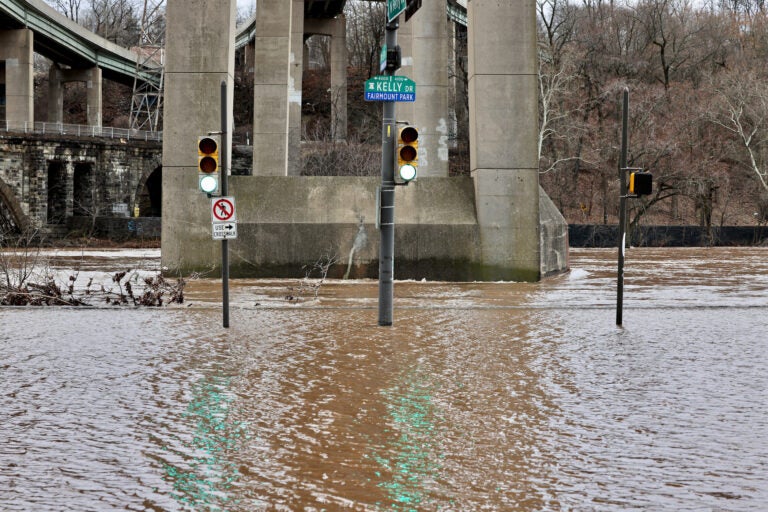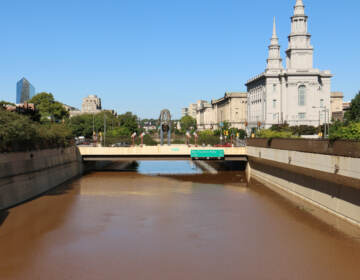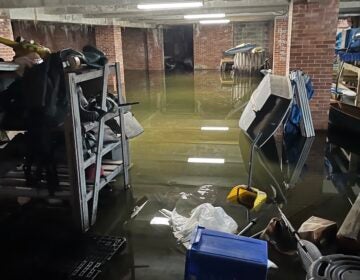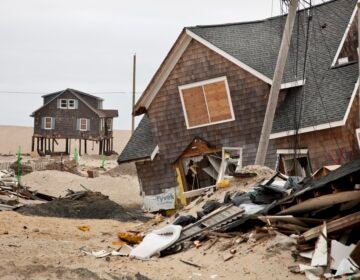Flood risk is increasing in the Philly region. Here’s what you need to know
Here’s what to do if you’re caught in a flash flood, how you can protect yourself from increased flood risk and how climate change factors in.

The Schuylkill River floods Kelly Drive at North Ferry Road, closing it in both directions from Midvale Avenue to West Hunting Park Avenue. (Emma Lee/WHYY)
Have a question about Philly’s neighborhoods or the systems that shape them? PlanPhilly reporters want to hear from you! Ask us a question or send us a story idea you think we should cover.
The Philadelphia region is at risk of increased flooding due to climate change, whether it’s coastal storm surge, sunny-day flooding along tidal rivers or flash flooding on inland roads.
Flooding can happen during a hurricane, in the days after one hits, during a bad thunderstorm or when a storm drain on your street backs up. Sometimes, even a smaller rainstorm combined with high tide can cause unexpected flooding.
People in Pennsylvania, Delaware and New Jersey are frequently trapped and rescued by boat during floods, and several floods in the region have been deadly. Numerous people died during the aftermaths of Hurricanes Sandy and Ida as well as during a 2023 summer rainstorm in Pennsylvania.
“Whether you’re in Rehoboth Beach or Cape May, you need to know where you’re at risk,” FEMA Regional Administrator MaryAnn Tierney told WHYY News. “You need to have a plan for what you’re going to do.”
What do the different weather warnings mean?
The National Weather Service issues weather notifications with varying degrees of certainty and severity. In general, a “watch” is less threatening than a “warning.” Here are some common flood-related messages and what they mean:
- Flood Watch: Flooding is possible
- Flood or Flash Flood Warning: Flooding, or flash flooding, is imminent or happening now
- Tropical Storm Warning: Sustained tropical cyclone-level winds are expected in the next 36 hours, potentially bringing storm surge, coastal flooding or river flooding
- Coastal Flood Warning: moderate to major coastal flooding that will pose a serious risk to life and property is happening or expected soon
You can find more detailed warning definitions on the National Weather Service website.
FEMA recommends signing up for local emergency notifications from your city, county or state.
For example, Philadelphians can sign up for ReadyPhiladelphia text alerts by texting “ReadyPhila” to 888-777, or can sign up online for emails or voicemails, and can specify up to five addresses for which they’d like targeted alerts. Delawareans can sign up for the Delaware Emergency Notification System to receive texts, emails and/or voice messages, and choose from a variety of preferred languages.
What to do if you’re caught in a flash flood
Flash floods can be surprisingly deadly. FEMA officials say just 6 inches of moving water can knock a person down, and a foot of water can sweep a car away.
If you’re caught in a flash flood, there are some steps you can take to stay safe.
- Don’t walk or drive into floodwaters
- Avoid bridges over fast-moving water
- Avoid underpasses
- If your car stalls in water, leave and get to higher ground
- If fast-moving flood waters surround your car and the car starts to fill with water, try to get on the roof
- Call 911 and provide your location as quickly as possible
How else can I protect myself and my family?
Emergency management officials say it’s important to make a plan for your household before flooding hits. This could include learning about evacuation routes, signing up for emergency alerts, making a family communication plan or putting together a preparedness kit with items such as a hand-crank radio, cell phone charger or pet food.
Make sure to take into account any mobility challenges, required medications or medical devices that may need electricity to run.
Take warnings seriously and evacuate if you’re advised to do so. Avoid driving or walking through water.
To reduce financial losses and the loss of keepsakes if your home floods:
- Elevate valuables ahead of any potential flooding. Store important documents or photos on upper floors
- Move your car out of the path of potential floodwaters
- Consider using water-resistant materials when doing renovations
- Consider purchasing flood insurance
What does climate change have to do with flooding?
Climate change is increasing the risk of flooding in the Philadelphia region by raising sea levels, driving more intense rain and fueling stronger storms.

Get daily updates from WHYY News!
WHYY is your source for fact-based, in-depth journalism and information. As a nonprofit organization, we rely on financial support from readers like you. Please give today.









